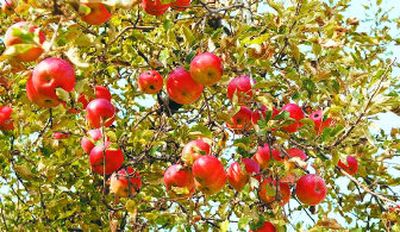Apple tree needs proper pest control

What do you do to keep worms from apple trees and when do you do it?
Dianne Henry, Spokane
There are several pests of apple trees that can be labeled as worms. The first step is to properly identify which “worm” you have. Contact your local Master Gardener clinic and talk to them about what your experiences have been. It’s a little early to have samples available to take to them but that would be the best thing to do. There are special sticky traps available that are hung in the trees to catch the adults which can then be identified. Proper identification will allow you to apply the proper control method.
Apple maggot is the larvae of a black fly about the size of a house fly. It overwinters in the soil and emerges as an adult fly in June and lays its eggs under the skin of the young fruit. The larvae tunnels through the fruit leaving a brown irregular track that can allow decay agents into the fruit and cause rot. Fruit often drops early and the larvae crawl out and burrow into the soil for the winter. Pick up fruit that falls early and destroy it. The trees can be sprayed with Malathion starting in early July and every 10 days until harvest. Nontoxic kaolin clay can also be sprayed on the trees starting in July to discourage the pests. However, it does leave the trees with a white ghostly appearance.
The other major “worm” pest is codling moth. This is the worst pest of apples in the state. It is a small moth with gray and white banded wings. It overwinters as mature larvae in a silken cocoon under loose bark on the trunk. The adults emerge about the time the trees bloom and lay their eggs on the newly emerging leaves. When the larvae hatch they begin feeding on the emerging fruit, boring into it to feed on the flesh and seeds. As they grow, they push the finely ground pulp or frass out their entry hole. After three or four weeks, the larvae emerge and move to a bark crevice to spin a cocoon. The larvae may over winter or reemerge in three or four weeks for another egg-laying session in July and August.
Given that the larvae over winter on the bark or other debris around the tree, be diligent about removing old fruit, branches and other brush around your tree. Rub the scaly bark off the trunk to remove hiding places. Some people wrap the trunks with burlap or cardboard to block the adult’s access to the trunk. To find out if you have them, set up special coding moth traps to check for the initial presence of the adult moth. Get the contents of the trap properly identified. Malathion can sprayed starting 10 days after full petal drop and then every 10 to 21 days through until harvest. The nontoxic kaolin clay applied as a spray to the leaves, branches and fruit has proved effective but needs to be reapplied periodically.